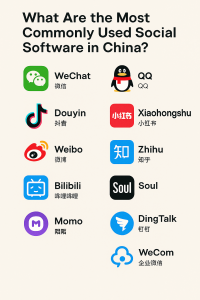
In today’s hyper-connected digital landscape, China has emerged as one of the most dynamic and unique ecosystems in terms of social networking platforms. Unlike much of the Western world, where platforms like Facebook, WhatsApp, and Instagram dominate, China’s internet environment has cultivated its own rich and highly integrated array of social software. These applications serve not only as communication tools but also as all-in-one platforms for entertainment, e-commerce, mobile payments, and work collaboration. This article provides an in-depth overview of the most commonly used social software in China as of 2025, alongside their major features and common Chinese nicknames.
1. WeChat (微信, Weixin) – The Super App of China
Overview:
WeChat is arguably the most ubiquitous and influential app in China. Developed by Tencent, it started as a messaging platform but has since grown into an all-encompassing lifestyle application.
Key Functions:
Instant messaging, voice/video calls
“Moments” (朋友圈) for social sharing
WeChat Pay (微信支付)
Official accounts for brands and services
Mini Programs (小程序)
Chinese nickname: 微信
Common Use: Everyone from students to seniors uses WeChat daily. It is not only used socially but also for work communication and even government services.
2. QQ (QQ) – The Pioneer Still Thriving
Overview:
QQ, also developed by Tencent, was the first popular instant messenger in China and remains widely used, especially among younger generations and gamers.
Key Functions:
Chatrooms and personal messaging
Qzone (QQ空间) for blogging and media sharing
Gaming integration
File sharing and cloud services
Chinese nickname: QQ
Common Use: Particularly popular among teenagers and in lower-tier cities where older desktops still dominate.
3. Douyin (抖音, TikTok China) – The Short Video King
Overview:
Douyin, the original version of TikTok developed by ByteDance, dominates the short video market in China with hundreds of millions of daily users.
Key Functions:
Short-form video browsing and creation
Livestreaming with virtual gifting
E-commerce integration (Douyin Mall)
AI-powered content recommendation
Chinese nickname: 抖音
Common Use: Used heavily for entertainment, marketing, and livestream shopping. Brands and influencers thrive here.
4. Xiaohongshu (小红书, RED) – Social Shopping and Lifestyle Inspiration
Overview:
Xiaohongshu is a blend of Instagram, Pinterest, and Amazon. It started as a cross-border shopping guide and evolved into a lifestyle sharing and product recommendation platform.
Key Functions:
“Notes” (笔记) with product reviews
KOL/influencer marketing
Community interaction
Integrated e-commerce
Chinese nickname: 小红书
Common Use: Particularly popular among young women for beauty, fashion, travel, and wellness content.
5. Weibo (微博) – China’s Twitter-Like Platform
Overview:
Weibo is a microblogging platform often referred to as “China’s Twitter”. It allows users to post, repost, and interact with trending news and entertainment.
Key Functions:
Public posts and reposts
Real-time trends and hashtags
KOL and celebrity engagement
News and event coverage
Chinese nickname: 微博
Common Use: Frequently used for following celebrities, breaking news, and social commentary.
6. Zhihu (知乎) – The Intellectual Community
Overview:
Zhihu is a Chinese equivalent of Quora, where users engage in question-and-answer discussions on professional, academic, and social topics.
Key Functions:
Q&A-based threads
Long-form articles
Paid knowledge content
Community votes and endorsements
Chinese nickname: 知乎
Common Use: Popular among educated young professionals and college students.
7. Bilibili (哔哩哔哩) – The Cultural Hub of Youth
Overview:
Originally an ACG (anime, comics, games) community, Bilibili has grown into a comprehensive video platform known for bullet comments (弹幕).
Key Functions:
UGC and PGC videos
Bullet comments overlaid on videos
Livestreaming
Subcultural communities
Chinese nickname: B站
Common Use: Especially popular with Gen Z for entertainment, gaming, learning, and community engagement.
8. Soul (Soul) – Avatar-based Social Networking
Overview:
Soul is a newer app that leverages AI to match users based on interests and personality traits rather than appearance.
Key Functions:
Avatar customization
Interest-based group chats
Voice-based interaction
Psychological tests and personality tags
Chinese nickname: Soul
Common Use: Increasingly popular among post-00s for anonymous or semi-anonymous socializing.
9. Momo (陌陌) – Location-Based Social Discovery
Overview:
Momo started as a dating app but evolved into a broader social discovery platform with livestreaming features.
Key Functions:
Nearby user discovery
Livestreaming and gifting
Interest groups
Event recommendations
Chinese nickname: 陌陌
Common Use: Still associated with casual dating but has grown into a broader social-entertainment space.
10. DingTalk (钉钉) and WeCom (企业微信) – Enterprise Communication
Overview:
For work-related communication, DingTalk (by Alibaba) and WeCom (by Tencent) are the two dominant platforms. These are akin to Slack and Microsoft Teams.
Key Functions:
IM for business
Workflow and task management
Video conferencing
Attendance and HR tools
Chinese nicknames: 钉钉 (DingTalk), 企业微信 (WeCom)
Common Use: Ubiquitous in Chinese enterprises, schools, and even government units for work and classroom coordination.
Why These Apps Dominate in China
The dominance of these platforms can be attributed to:
Integration of Features: Unlike Western apps that specialize, Chinese apps bundle social, payment, gaming, shopping, and more.
Mobile-first Design: Most apps are optimized for smartphones and integrate well with China’s cashless society.
Local Policies: Foreign platforms like WhatsApp, Facebook, or Instagram are blocked, giving domestic apps full control of the ecosystem.
Ecosystem Lock-in: Apps like WeChat and Alipay are deeply integrated into daily life, from paying utility bills to hospital registration.
Closing Thoughts
Understanding China’s social software ecosystem is essential for businesses, marketers, and anyone looking to enter the Chinese market. These platforms are more than communication tools—they shape how people shop, work, entertain, and express themselves.
For anyone planning to live, work, or do business in China, becoming familiar with WeChat (微信), Douyin (抖音), and Xiaohongshu (小红书) is a vital step toward meaningful engagement in the digital Chinese world.


